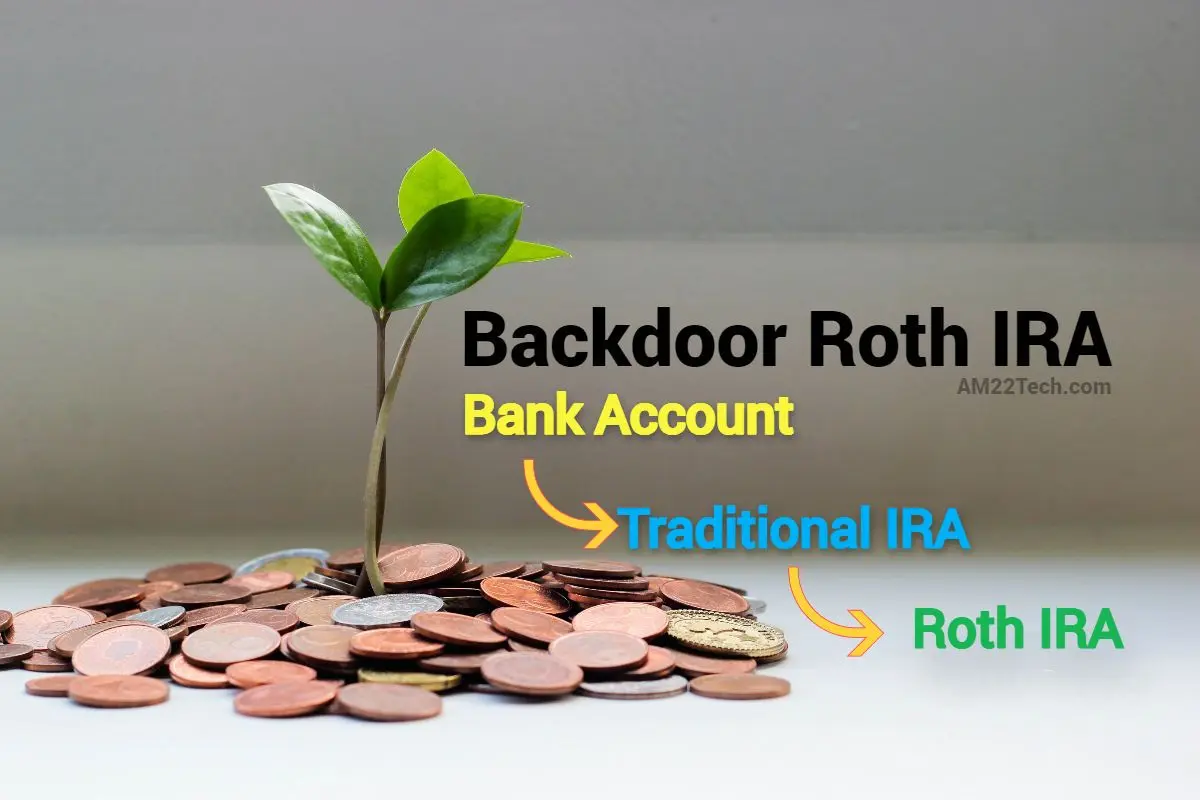Backdoor Roth IRA Fidelity If you’re seeking a way to save for retirement that offers tax advantages, you’ve probably heard of Roth IRAs. But what happens if your income is too high to contribute directly to one? That’s where a Backdoor Roth IRA Fidelity comes into play. This strategy could be just the ticket for high-income earners who want to benefit from tax-free growth. In this guide, we’ll break down what a Backdoor Roth IRA is, how to set one up with Fidelity, and why this might be the retirement strategy you need.
What is a Backdoor Roth IRA?
A Backdoor Roth IRA is not a particular type of retirement account but a creative strategy for people whose income surpasses the limits set for contributing to a Roth IRA. It involves contributing to a traditional IRA with a limit and converting it into a Roth IRA. The Backdoor Roth IRA Fidelity option is an excellent way for those who earn too much to still enjoy the benefits of a Roth IRA, including tax-free withdrawals in retirement.
Who Should Consider a Backdoor Roth IRA?
This strategy is not for everyone but can be highly beneficial under the right circumstances. Consider a Backdoor Roth IRA Fidelity if:
- Your income exceeds the Roth IRA contribution limits set by the IRS.
- You are looking for tax-free growth on your investments.
- You already max out your other retirement savings options, like a 401(k).
Why Choose Fidelity for Your Backdoor Roth IRA?
Fidelity is one of the most popular investment firms for handling Backdoor Roth IRAs, and it’s easy to see why. Their platform is user-friendly, and they provide excellent customer service. Backdoor Roth IRA Fidelity is often considered a reliable choice for its low fees and wide range of investment options. Fidelity also offers a wealth of educational resources, making it easier for beginners to understand the process.
Income Limits for Roth IRA Contributions
Before diving into how to set up a Backdoor Roth IRA, it’s essential to understand why it might be necessary. The IRS imposes income limits for direct Roth IRA contributions, which are updated annually. For 2023, the contribution limits phase out for individuals with Modified Adjusted Gross Incomes (MAGIs) above \$153,000 (for single filers) and \$228,000 (for joint filers).
If your income exceeds these limits, you won’t be eligible to contribute directly to a Roth IRA. But with a Backdoor Roth IRA Fidelity, you can work around this and still reap the benefits of a Roth IRA.
Steps to Set Up a Backdoor Roth IRA with Fidelity
Let’s walk through setting up a Backdoor Roth IRA Fidelity in simple terms. Fidelity makes it easy to carry out each step, and we’ll break it down to help you get started.
Step 1: Open a Traditional IRA
The first step is to open a traditional IRA. If you already have one with Fidelity, you can skip this step. Just make sure the account is set up correctly to receive non-deductible contributions.
- Log into your Fidelity account.
- Navigate to the section to open a retirement account.
- Choose “Traditional IRA” and fill out the required details.
Step 2: Make a Non-Deductible Contribution
Once your traditional IRA is open, the next step is to make a non-deductible contribution. The annual limit for IRA contributions is \$6,500 if you’re under 50 and \$7,500 if you’re over 50.
- Contribute up to the annual limit.
- Make sure that the contribution is marked as “non-deductible.”
This means you won’t get an immediate tax deduction, but it sets you up perfectly for the conversion process.
Step 3: Convert the Traditional IRA to a Roth IRA
Now comes the critical step—converting the money from your traditional IRA into a Roth IRA. This process is essentially what makes it a “backdoor” Roth IRA.
- Navigate to the “Transfer” section on your Fidelity account.
- Choose to transfer funds from your traditional IRA to a Roth IRA.
- Select “Convert to Roth IRA” and follow the prompts.
Step 4: Report the Conversion to the IRS
The IRS must know about your conversion, so you must report it properly on your tax return. Fidelity provides the forms you’ll need at the end of the year, but you’ll also have to fill out IRS Form 8606 to indicate a non-deductible contribution and conversion.
The Benefits of a Backdoor Roth IRA
Tax-Free Growth and Withdrawals
One of the significant advantages of a Roth IRA is that your investments grow tax-free, and qualified withdrawals are tax-free. With a Backdoor Roth IRA Fidelity, you get the same benefits even if you don’t qualify for a direct Roth IRA contribution.
- Contributions are made with after-tax dollars.
- Investments grow without the burden of taxes.
- Withdrawals after age 59½ are tax-free.
No Required Minimum Distributions (RMDs)
Unlike traditional IRAs, Roth IRAs do not require you to take Required Minimum Distributions (RMDs) during your lifetime. This is a significant benefit for those who want to let their money grow undisturbed.
Important Considerations
Before you rush into opening a Backdoor Roth IRA Fidelity, there are a few things you should keep in mind:
- Pro Rata Rule: If you have other traditional IRA assets, the IRS will apply the “pro rata” rule, which means your conversion will include a percentage of pre-tax and post-tax dollars. This can complicate your tax situation.
- Tax Implications: If you have existing traditional IRA funds that were deducted from your taxes, the conversion will create a tax event.
The Pro Rata Rule Explained
The pro rata rule can be one of the more complex aspects of a Backdoor Roth IRA Fidelity. When you convert funds from a traditional IRA to a Roth IRA, you cannot choose to convert just the non-deductible contributions—the IRS requires you to convert a proportionate amount of all your IRA funds. Here’s how it works:
| IRA Type | Pre-Tax Amount | Non-Deductible Amount | Total IRA Balance | Percentage of Conversion Subject to Tax |
|---|---|---|---|---|
| Traditional IRA | \$30,000 | \$6,000 | \$36,000 | 83.3% |
In this scenario, only a portion of your conversion would be non-taxable, so planning ahead is essential.
Why Timing Matters
When performing a Backdoor Roth IRA Fidelity conversion, timing can make a big difference. Ideally, you want to contribute to the traditional IRA and convert to a Roth IRA as soon as possible. This reduces the time the money has to grow, which minimizes any potential gains that could be taxed during the conversion.
- Contribute.
- Convert to a Roth quickly to avoid unnecessary taxes on gains.
How Fidelity Makes the Backdoor Roth IRA Easier
One of the reasons many people choose Fidelity for their Backdoor Roth IRA is the platform’s simplicity. Fidelity’s interface is straightforward, and their customer service representatives can walk you through the process if you are unsure. They also provide detailed information and tax documents to help you during tax season.
Investment Options with Fidelity
Once your Backdoor Roth IRA Fidelity is up and running, you’ll have access to a variety of investment options, including:
- Mutual Funds: Fidelity offers a wide selection of mutual funds, including their no-fee index funds.
- Exchange-Traded Funds (ETFs): ETFs can be a cost-effective way to diversify your portfolio.
- Individual Stocks: You can also buy and hold individual stocks within your Roth IRA, allowing you to tailor your investments.
Common Mistakes to Avoid
While the process is pretty straightforward, there are common mistakes that can complicate a Backdoor Roth IRA Fidelity:
- Forgetting to File IRS Form 8606: If you fail to report the non-deductible contribution, you could face penalties or pay more taxes than necessary.
- Waiting Too Long to Convert: If you wait too long between contributing to a traditional IRA and converting to a Roth IRA, you may end up with taxable earnings, complicating the conversion.
- Ignoring the Pro Rata Rule: If you already have traditional IRA funds, failing to consider the pro rata rule can result in an unexpected tax bill.
Optimistic Outlook: The Future of Your Roth IRA
Establishing a Backdoor Roth IRA Fidelity is an excellent way for high-income earners to secure a future filled with tax-free growth. By following these simple steps and avoiding common pitfalls, you can ensure that you’re on the path to a financially comfortable retirement. Fidelity’s tools and customer support can make the journey even smoother.
Remember, while it might seem like a lot of hoops to jump through, the potential for tax-free income during retirement can make it well worth the effort. With a Backdoor Roth IRA Fidelity, you can bypass the income limits and build the kind of retirement nest egg that dreams are made of.
Final Thoughts on Backdoor Roth IRA Fidelity
The Backdoor Roth IRA Fidelity strategy is perfect for high earners to take advantage of tax-free growth, even if they don’t qualify for direct contributions to a Roth IRA. By working through the steps of contributing to a traditional IRA and converting to a Roth, you gain access to one of the most valuable retirement savings tools available.
If you’re looking for a way to maximize your retirement savings and are willing to do a bit of extra paperwork, the Backdoor Roth IRA Fidelity could be the right choice. It may seem complex, but the reward—tax-free growth and withdrawals—is well worth it. And with Fidelity as your partner, the process is more straightforward and spread than expected.
Ready to take control of your retirement savings? Consider exploring your options with a Backdoor Roth IRA Fidelity today, and make your financial future a priority.




